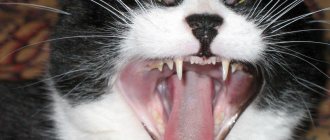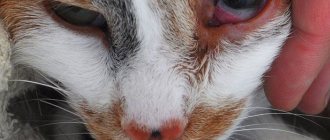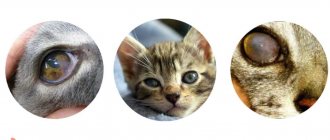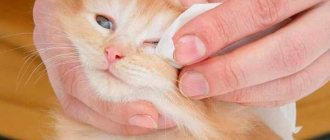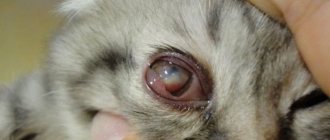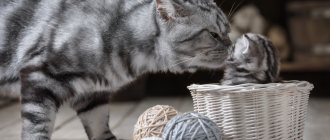For the longevity and cheerfulness of a pet, its owner is obliged to closely monitor the health of his own pet. One possible problem could be a brown spot on your cat's eye. The appearance of such a pathology may indicate disturbances in the functioning of the cat’s organ of vision. So, if symptoms of the disease occur, it is recommended to contact a veterinarian in a specialized clinic to examine the animal, make an accurate diagnosis and prescribe the correct treatment.
Why can cats' eyelids swell?
There are several main reasons.
Blepharitis.
A disease in which the eyelids become swollen, red, and inflamed. May be caused by infection, bacterial infection, or mechanical trauma. If you have blepharitis, you should immediately consult a veterinarian. If the disease progresses, ulcers may form on the eyelids and cicatricial inversions may appear. Treatment of blepharitis comes down to eliminating the causes of inflammation. A veterinarian-ophthalmologist will select and prescribe antibacterial drugs and anti-inflammatory drugs. It is important to understand that blepharitis causes a lot of discomfort for your cat. She may try to rub and scratch her eyes, as a result of which the condition of the eyelids will only worsen. Therefore, it is necessary to relieve the main symptoms as quickly as possible.
Allergic reaction.
Eyelids may become swollen due to allergies. In this case, additional symptoms may appear: runny nose, discharge from the eyes, etc. Most often, allergies are caused by food or household chemicals. To restore the cat's normal well-being, antihistamines and anti-inflammatory drugs are used.
Eyelid injuries.
A foreign object getting into the eye or trauma to the eye with a hard object may well cause swollen eyelids in a cat. The task of a veterinary ophthalmologist in such a situation is to establish the severity of the injury, numb the area of the eyelids and eyes, and remove foreign bodies, if any. After an injury, anti-inflammatory drugs can be used to speed up the healing of the eyelids.
Infectious, fungal, bacterial infection.
As a rule, swelling of the eyelids in such cases is accompanied by additional symptoms. Treatment is prescribed by the doctor in accordance with the diagnosis.
If your cat's eyelids are swollen, under no circumstances should you self-medicate. It is necessary to show your pet to an ophthalmologist as soon as possible. He will be able to accurately determine the cause of eyelid swelling and prescribe effective and safe therapy. Self-treatment may not only not help the cat, but also worsen the situation - even to loss of vision.
Veterinary ophthalmologists at the Oculus Center will conduct diagnostics and determine the exact reasons why your cat’s eyelids are swollen. Our specialists have extensive experience and have modern diagnostic equipment. We will prescribe effective treatment for your pet, carry out the necessary procedures, and help quickly relieve discomfort.
First aid
It happens that it is not possible to immediately contact a veterinarian. Then it is recommended to take measures to provide first aid to alleviate the pet’s condition:
- ensure peace, eliminate stress factors;
- apply cold to the affected area - this slightly relieves swelling;
- do not touch your eyes unnecessarily, do not rub or massage them;
- Do not treat the animal yourself.
The main principle of first aid is to do no harm. If possible, it is necessary to reduce the pet’s suffering as much as possible and take it to a veterinary clinic.
Demodicosis
The disease develops as a result of infection by a subcutaneous mite. The pathogen penetrates the epithelium, feeding on its cells. As with lichen, the most common areas affected are behind the ears and on the paws. First, a small red spot appears in the bite area, and then a tubercle, which grows over time and begins to fester. Hair loss does not always occur, only in advanced stages. Most often, the fur becomes brittle and grows less densely.
The diagnosis is made based on the results of a deep scraping. Treatment is carried out using sulfur-based ointments. For bathing, use anti-scabies shampoos with chlorhexidine. It will take a long time to treat your pet: from 1.5 to 3 months. As prescribed by the doctor, ivermectin preparations are administered subcutaneously. Demodectic mange is a disease that affects animals with weakened immune systems, which is why to prevent re-infection, you should provide your pet with adequate protein nutrition and vitamins.
Main causes of tumor
There are many factors that can provoke the appearance of a tumor. Before starting treatment for your pet, it is important to determine what caused such a symptom. Experts identify the following main causes of eye pathologies:
- Injury. A common factor that contributes to the formation of swelling is trauma. If a cat hits its head hard, it may develop traumatic swelling. Fights between a pet and another cat can also become the root cause of eye damage. Wounds of the eyelid can be superficial, deep or through. In this case, the swelling of the eyelid is accompanied by redness of the eyes or slight bleeding. If the wound is shallow, it will heal on its own and the swelling will subside. If there is deep damage to the eyelid, it is necessary to put a bandage on the pet’s eye and take it to the veterinarian.
- Foreign object. A foreign body entering the eye can also cause a tumor. Sand, thorns or some plant can get into the middle. In this case, the eye becomes hot to the touch and exudate oozes from it. Trying to remove the item yourself is not recommended. It's best to take your four-legged friend to the vet.
- Avitaminosis. With vitamin deficiency or metabolic disorders, cats sometimes experience inflammation of the eyelids. For simple inflammation (swelling appears and the edges of the eyelids become red), it is important to use an antibiotic ointment. Oxycort and prednisolone will help your pet recover quickly. Phlegmous inflammation manifests itself in the form of swelling of the eyelid and is accompanied by a purulent abscess. If a cat has such a tumor under the eye, it is recommended to immediately visit a veterinarian and open the abscess. The specialist may prescribe a course of injections, as well as further washing of the eyelid with chamomile or a 3% solution of boric acid.
- Conjunctivitis and keratitis. Inflammation of the eye in the form of conjunctivitis and keratitis is another reason for the formation of a tumor. In the first case, swelling appears around the eye, and redness is also noticed. With conjunctivitis, most often there is increased lacrimation and accumulation of mucous secretions in the corner of the eye. To treat the disease, eye drops are used (0.25% solution of novocaine or chloramphenicol, as well as sofradex or 1% solution of kanamycin).
- Oncology. The previously listed types of eye diseases respond well to treatment. If you quickly determine the cause of the swelling of the eye and undergo a course of procedures, your pet will soon recover. In some cases, a tumor under a cat's eye may indicate the presence of cancer. The pet loses vision and develops swelling under the eyes. Only a veterinarian must treat a malignant tumor.
- Blepharitis. Cats sometimes develop swelling under the eye due to inflammation of the eyelids - blepharitis. In addition to swelling of the eyelids, such a pathology is also accompanied by painful sensations. The eyelids become hot and tense when touched. Blinking provokes painful sensations in your pet, which is why most often he lies with his eyes closed.
- Heart and kidney disease. If a cat's eyelids are swollen, then in some cases this indicates a dangerous disease of the internal organs. In this case, the excretory and cardiovascular systems suffer. The general malaise of the cat should alert its owner. A veterinarian must diagnose and treat the disease.
How to help your pet?
A few simple safety measures will save the health, and maybe even the life, of your family pet. It is important to adhere to the following rules after identifying a tumor under a cat’s eye:
- Do not take any therapeutic measures on your own. If swelling under the eye is detected, you must visit a veterinarian and adhere to a further course of treatment;
- Applying a cold compress to the sore eye can relieve your pet's suffering. In this case, the swelling will subside a little, after which it is important to show the cat to a specialist;
- Massaging and rubbing the eye is prohibited! Such measures will only increase the cat’s suffering and cause further development of the pathology;
In the desire to help your beloved cat get rid of painful sensations, it is important not to harm. Carrying out home procedures after consultation with a veterinarian will contribute to a speedy recovery of your four-legged friend.
Causes of the disease
A disease in which a cat's eyes are half covered with a film is not so rare. The filmy layer on the surface of a cat's eyelids (on the inside) in most cases is white. Sometimes it covers a significant part of the animal's eye. It doesn’t look pretty, and the pet’s well-being worsens. Therefore he should be helped. To overcome a disease in which your pet's eyes are half covered with a film, you need to know the causes of the pathological condition.
The third eyelid (this is the name given to the film that covers a cat’s eyes) is the conjunctiva. It covers the surface of the eyelids (lower and upper), as well as the eyeball. In cats, in the inner corners of the eyes there is a fold of the conjunctiva (nictitating membrane). It ensures the full functioning of the visual organ.
It is impossible to see the fold with fully open eyes (if they are healthy). It becomes noticeable only when the animal squints its eyes or blinks. The nictitating membrane contributes to:
- proper distribution of tear fluid;
- removal of foreign elements from the surface of the visual organ (for example, dust, grains of sand);
- producing up to 1/3 of tear fluid.
If a cat’s fully open eyes suddenly become half covered with a film, this indicates the development of negative processes in the animal’s body. There are many topics on veterinary forums about the appearance of a film on a cat’s eyes. This pathology is associated with prolapse of the 3rd eyelid. It occurs due to swelling of the nictitating membrane, the functions of which are impaired. The animal's eyes do not receive the required amount of moisture, so they become more vulnerable to negative factors.
The opposite situation may also arise when the visual organ of a pet suffers from excess moisture. There are many reasons why a cat's third eyelid may fall out. In fact, this pathology is not the main disease. This is more likely a sign of another disease. For example:
- conjunctivitis;
- infections caused by bacteria;
- diseases of internal organs (most often associated with disruption of the digestive tract);
- parasites in the animal's body;
- mechanical eye damage;
- foreign objects getting into the cat’s eyes, causing injury, inflammation and swelling;
- cataracts, blockage of the eye vessels, strabismus (the presence of such problems is indicated by the blue color of the film on the eyes).
If you notice that a film has begun to appear on your pet cat's eyes, take the animal to the veterinarian as soon as possible. Timely diagnosis and proper treatment will help avoid re-infection and quickly restore the health of your furry pet. Using an ophthalmoscope, a specialist will quickly find out the cause of eye inflammation and offer a high-quality and effective course of treatment. If it turns out that the film on the cat’s eyes is due to cataracts or blockage of the vessels of the visual organ, surgical intervention is performed.
Panophthalmitis
Panophthalmitis is a serious condition that causes severe inflammation of the eyes. In this case, damage to all tissues of the animal’s visual organs is observed. The disease is a complication of injuries and injuries to the eyeball.
The development of panophthalmitis is caused by a purulent infection that enters the eye through damage. The causative agents of this pathological process can be various bacteria:
- white and golden staphylococci;
- pneumococci;
- streptococci;
- in rare cases, Escherichia coli and Pseudomonas aeruginosa.
Symptoms of panophthalmitis include:
- manifestation of sharp pain in the eye;
- fear of bright light;
- increased fluid secretion;
- frequent uncontrolled closing of the eyelids;
- severe swelling of the eyelids of the conjunctiva of the eyeball;
- pinching of the mucous membrane of the eye;
- When examined, the cornea may be very cloudy and swollen. Sometimes purulent discharge may be present;
- decline in visual function.
Treatment depending on the cause of the appearance of the ball under the skin
If a neoplasm is noticed in an animal, it is necessary to contact a veterinarian. The tumors are removed; no ointments can help with their treatment. If the lump is due to suppuration, it is opened and washed with a disinfectant solution.
When a hernia appears, it is removed with massage or a tight bandage. In extreme cases, surgical removal is resorted to.
Lipoma is rarely removed; in most cases it is treated with ointments and other medications.
Mastitis responds well to treatment with compresses and antibiotics. Sometimes massage is used. For mastitis, a novocaine blockade, physiotherapy, and, in extreme and advanced cases, surgery are also often prescribed.
Cancerous formations are treated with chemotherapy, and then surgery is performed with further removal. It is important to pay attention to whether metastases have occurred, so as not to waste time and take the right treatment tactics.
Prevention measures
If you notice that the corners of your cat's eyes are covered with a film, take preventive measures to avoid further spread of the veil on the visual organ. There are good preventative measures to prevent film from appearing on your cat’s eyes.
- Use a special solution to wash your cat’s eyes (you can use chamomile decoction). Soak a cotton swab in it well, and then gently rinse your pet’s one and other eyes. When you complete the procedure, do not forget to blot the cat's eyes with a dry cotton pad.
- Before starting preventive eye rinsing, wash your hands well with soap to prevent infection from entering the inflamed organ.
- Review your cat's diet, make it more balanced, varied and correct.
Remember that early detection of health problems will avoid questions as to why the cat's eyes are half closed with film. Do not self-medicate under any circumstances; it is better to immediately visit a veterinarian with your pet. He will prescribe adequate treatment that will not cause severe harm to your purr’s body. It will help get rid of film on the eyes and improve the cat’s health.
Recommended clinics
If you find lumps on your cat’s belly, you should contact a clinic that immediately has a surgeon, oncologist and dermatologist to quickly determine the cause and further treatment.
Moscow
- Veterinary clinic White Fang. There is a branch in Kaliningrad. They work around the clock. There is an MRI machine. There is an oncology department.
- Network of veterinary clinics Medvet. Vilkovysky I.F. - chief physician, head of the surgical department, leading surgeon. Candidate of Veterinary Sciences.
- Veterinary center Komondor. Wide range of veterinary services. There is an animal rehabilitation unit. The clinic’s doctors are active participants in veterinary conferences and symposiums.
Saint Petersburg
- Vetus veterinary clinic network. Oncologist Tamoshkin D.A. – chief physician, lecturer at St. Petersburg veterinary surgical conferences.
- Pride Cancer Center. MRI available. Chief physician Bryushkovsky K.Yu. He is a candidate of veterinary sciences and teaches at the St. Petersburg State Academy of Veterinary Medicine.
Murmansk
- Animal care. The clinic has been operating since 2006. Chief physician Ivaneeva O.E. - a general specialist.
- Clinic Ivetas. The first clinic in Murmansk with equipment for endoscopic operations and other types of research.
- Veterinary clinic Favorit. Conducts a wide range of diagnostic and therapeutic procedures. Cooperation has been developed with the Clinic of Neurology and Intensive Care of Dr. V.V. Sotnikov, St. Petersburg, and the White Fang Clinic, Moscow.
Read other articles about cats on the Guardian of Purity portal. Stay with us!
Detailed description of common causes
If a cat has a swollen upper eyelid, then first of all the possibility of congenital pathologies associated with abnormal eyelash growth is excluded. If there is swelling in the lower eyelid and there are signs of inflammation, then consider options with blepharitis, which can be caused by a bacterial or fungal infection. But, before making a diagnosis, it is imperative to exclude the following possible causes of this symptom:
- Blepharitis. An inflammatory process caused by injury, an allergic reaction or bacterial infection. With blepharitis, a cat's eyelids almost always become swollen and there is discomfort caused by excessive tearing due to stuck together eyelashes. In many cases it occurs together with conjunctivitis. Blepharitis is not considered an independent disease; its appearance is always provoked by something, so symptomatic treatment is ineffective. This is especially true for cases associated with congenital pathologies (third eyelid prolapse). Once the cause is eliminated, swelling and redness almost always subside. As a preventive measure, eye drops with anti-inflammatory and antibacterial effects can be prescribed.
- Foreign body. Plant seeds, weed thorns or cactus needles can also become embedded in the mucous membrane of the eyelid. Therefore, if a cat has a swollen eyelid, then the option of a splinter should be ruled out first. The danger of foreign bodies is that they can injure the cornea during blinking. This can lead to the development of uveitis and keratitis. In many cases, owners manage to get splinters out on their own without the help of a veterinarian. But, to eliminate the possibility of infection, all instruments (usually tweezers are used) must be thoroughly treated with an antiseptic solution. After this, you can use antibacterial and anti-inflammatory drops for 2-4 days. In difficult cases, surgical intervention is required. If you ignore the problem, then everything can end with purulent conjunctivitis and keratitis, due to which the pet’s quality of vision may decrease.
- Injury. Most often, damage to cats occurs after street fights. In pets, such injuries occur after active games or falls from a height. Therefore, if a cat’s eyelid is swollen after a blow, then you should consider the option of a hematoma or bruise, which most often goes away on its own within a few days. During this period, much attention is paid to the eye itself. At the slightest suspicion of purulent discharge or souring of the eyes, it is recommended to immediately contact a veterinarian.
- Abnormal eyelash growth. This is when one or more eyelashes grow incorrectly from birth, thereby injuring the cornea. Because of this, an inflammatory process begins, which results in redness and swelling of the eyelid, cornea and white of the eye. Associated symptoms include increased lacrimation and purulent discharge from the eyes. If the problem is neglected, the development of uveitis and deep keratitis cannot be avoided. The best solution to the problem of double rows or abnormally growing eyelashes is hair removal.
- Turning of the eyelids. Most often found in decorative breeds (Maine Coon, exotics, Scots, British). In Persians, this defect is considered congenital, so it manifests itself already in the first months of life. This manifests itself in the fact that the eyelid turns inward, thereby irritating and injuring the cornea. At the initial stage, the problem will manifest itself in slight swelling and redness of the eyelids, lacrimation. If the issue is not resolved at this stage, then there is a high probability that complications will appear in the form of clouding of the cornea and purulent discharge from the eye. Conservative methods, unfortunately, are ineffective, so the best option is considered to be surgical intervention, during which an incision is made and excision of eyelid flaps. After suturing, nothing else touches the cornea. Complete healing will take 2 to 4 weeks.
In kittens aged 2 to 6 months, the eyelid may become swollen due to respiratory viral infections. But complications affect both organs of vision at once. In case of a single lesion, the option of trauma and congenital pathologies of the eyelid is considered (especially in Persian cats).
Blepharitis
During blepharitis, a bilateral, recurrent pathological process of the ciliary edge of the eyelid is observed. Almost all representatives of the cat family are prone to this disease, regardless of gender and age.
Blepharitis can be caused by various reasons, the most popular include the following:
- dermatitis;
- damage to the skin of the eyelid;
- turning of the eyelids. This condition is often seen in Persian and Himalayan cats;
- parasitic organisms, namely subcutaneous mites (demodex). In these cases, damage to the eyes, muzzle, and neck is observed;
- fungal diseases;
- allergic reactions;
- seborrhea. During this disease, there is the formation of a large amount of dandruff on the skin and scales on the eyelids;
- diseases of an endocrine and autoimmune nature.
Important! Blepharitis usually causes severe swelling and redness of the surface of the eyelid. The edges become denser and thicker. Also in the zone of ciliated growth, the formation of gray scales is observed.
